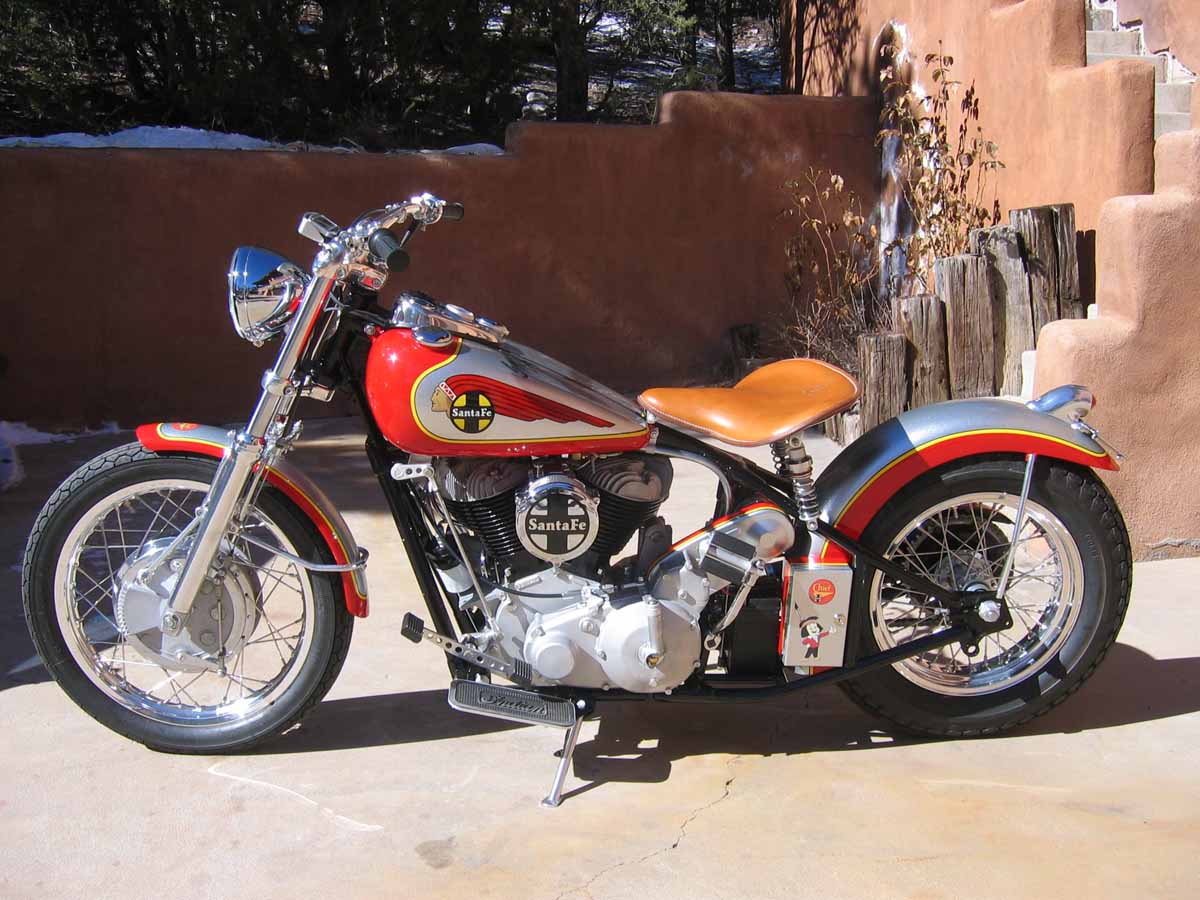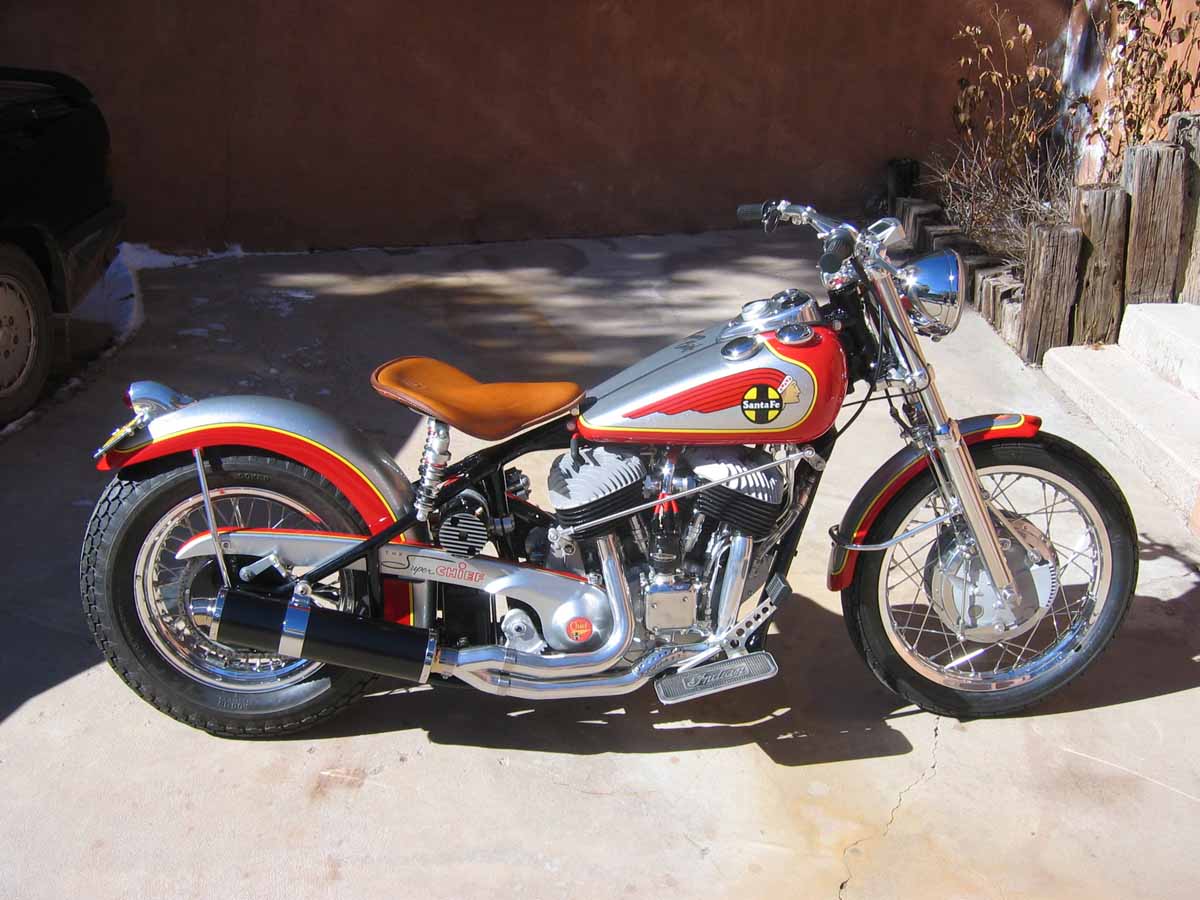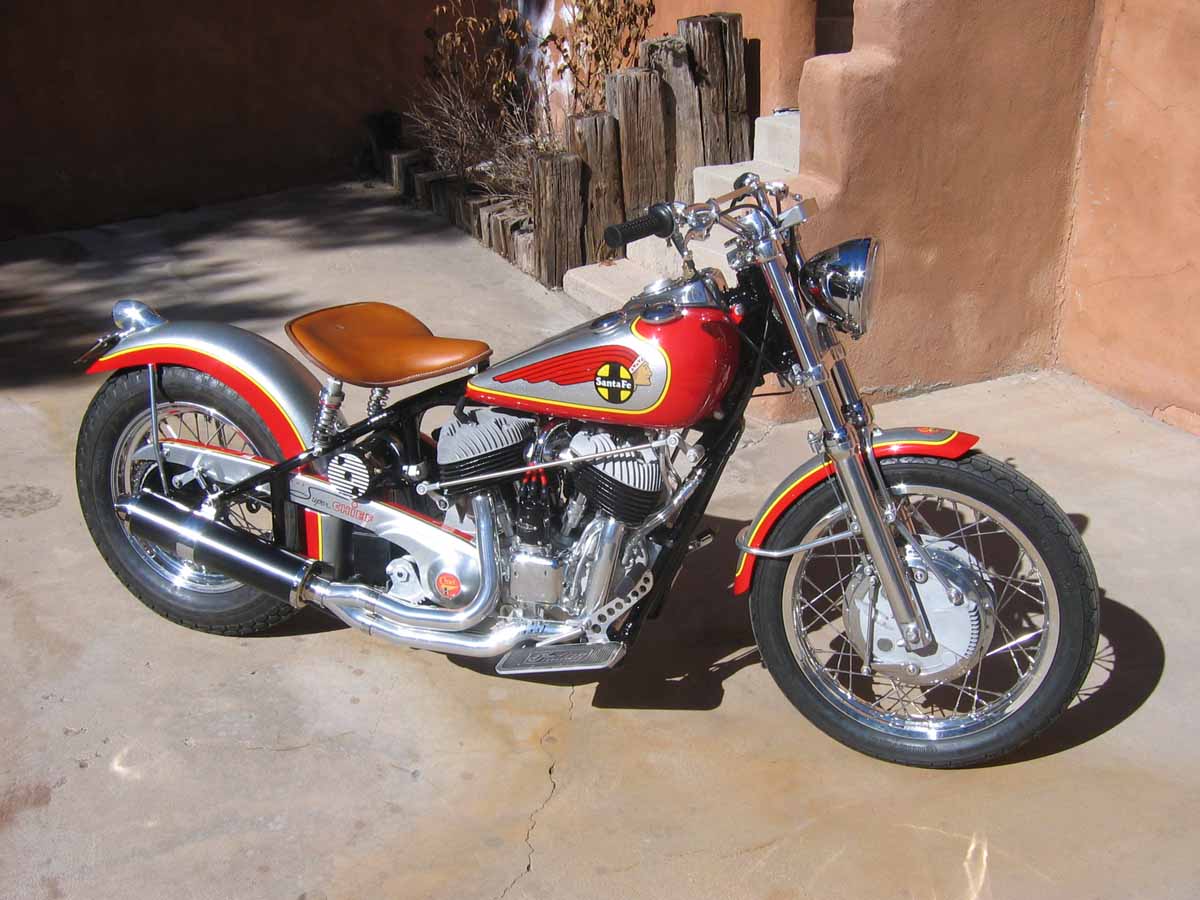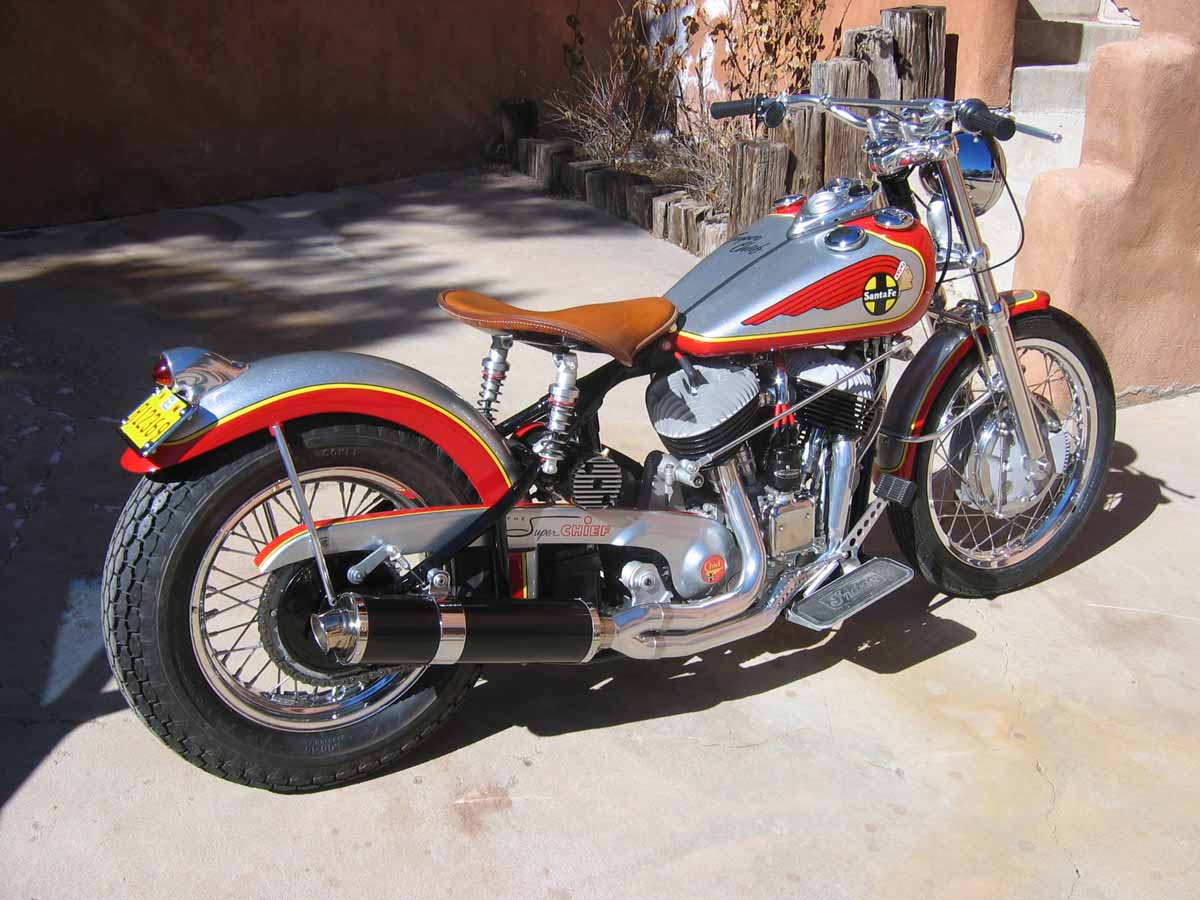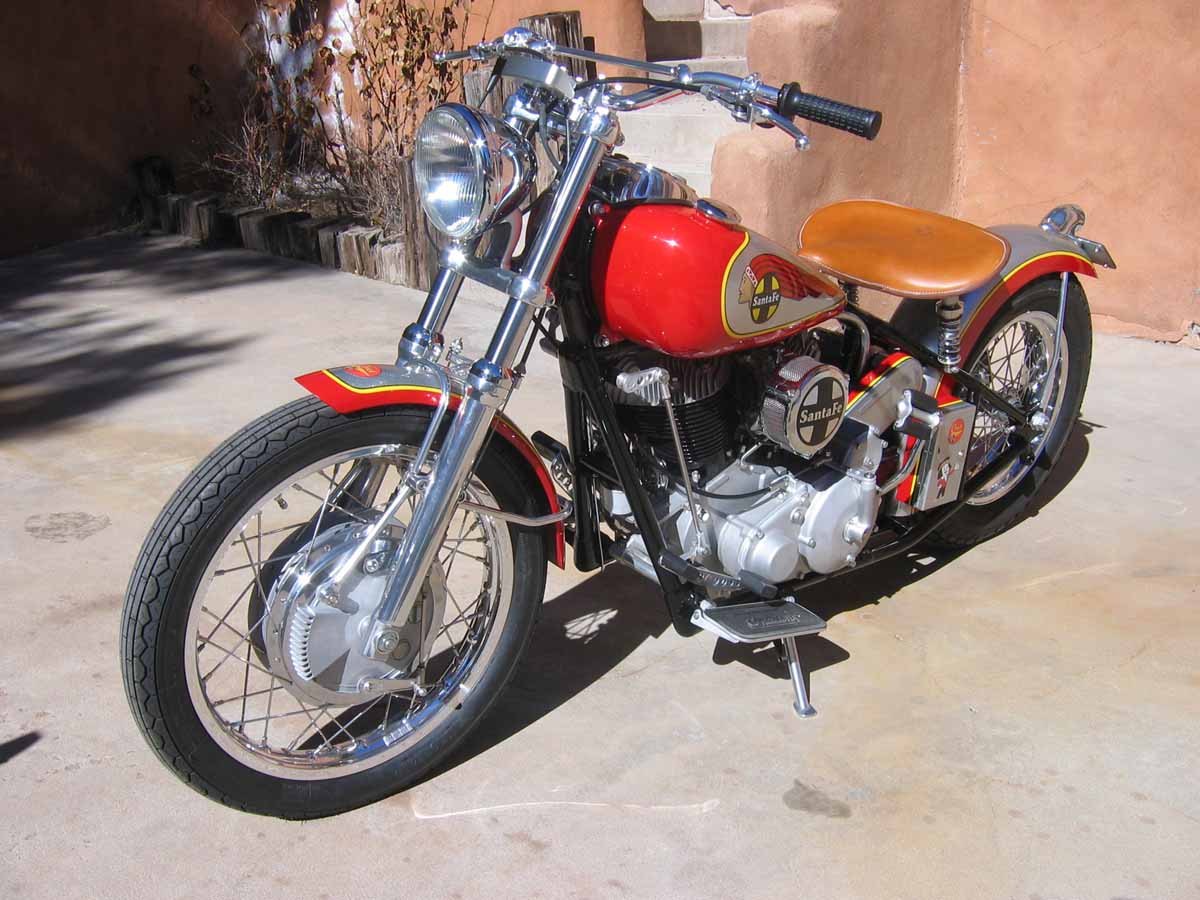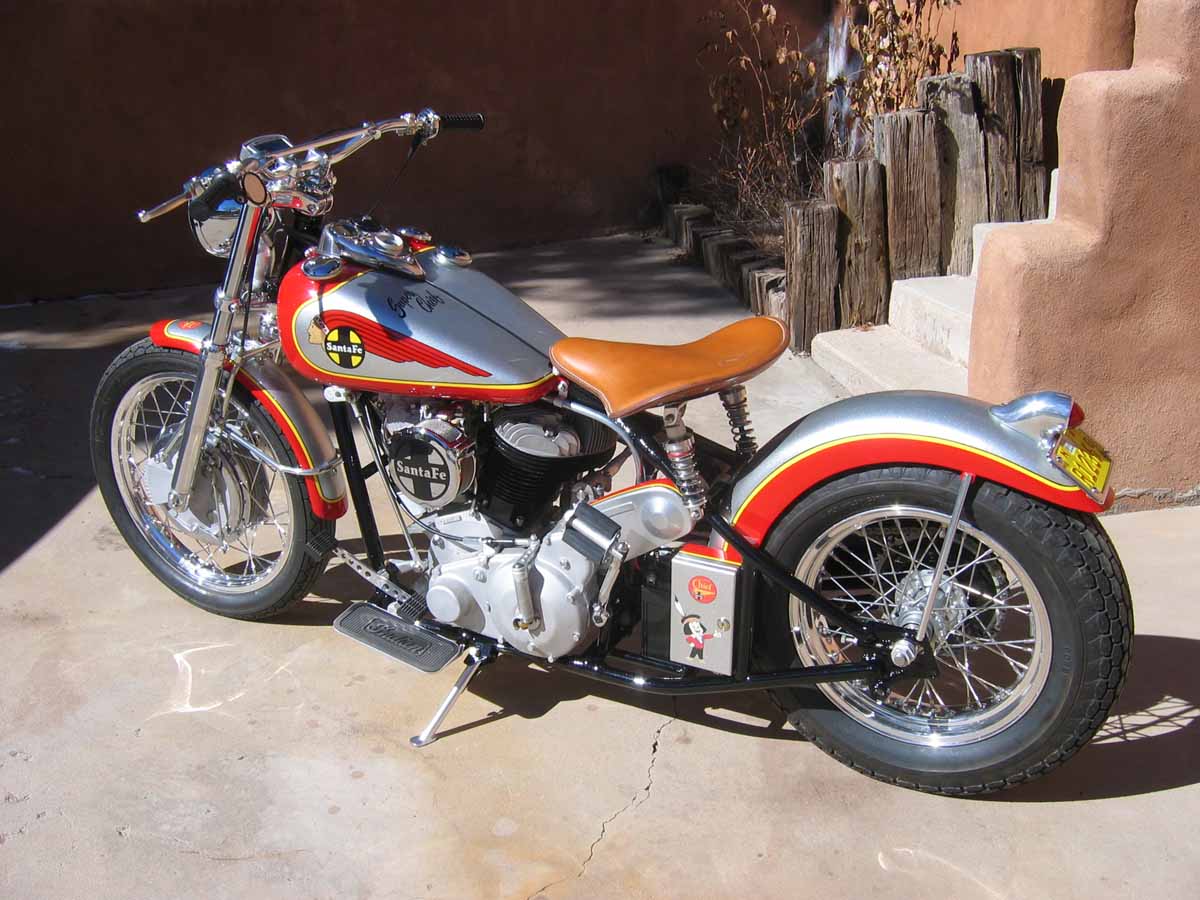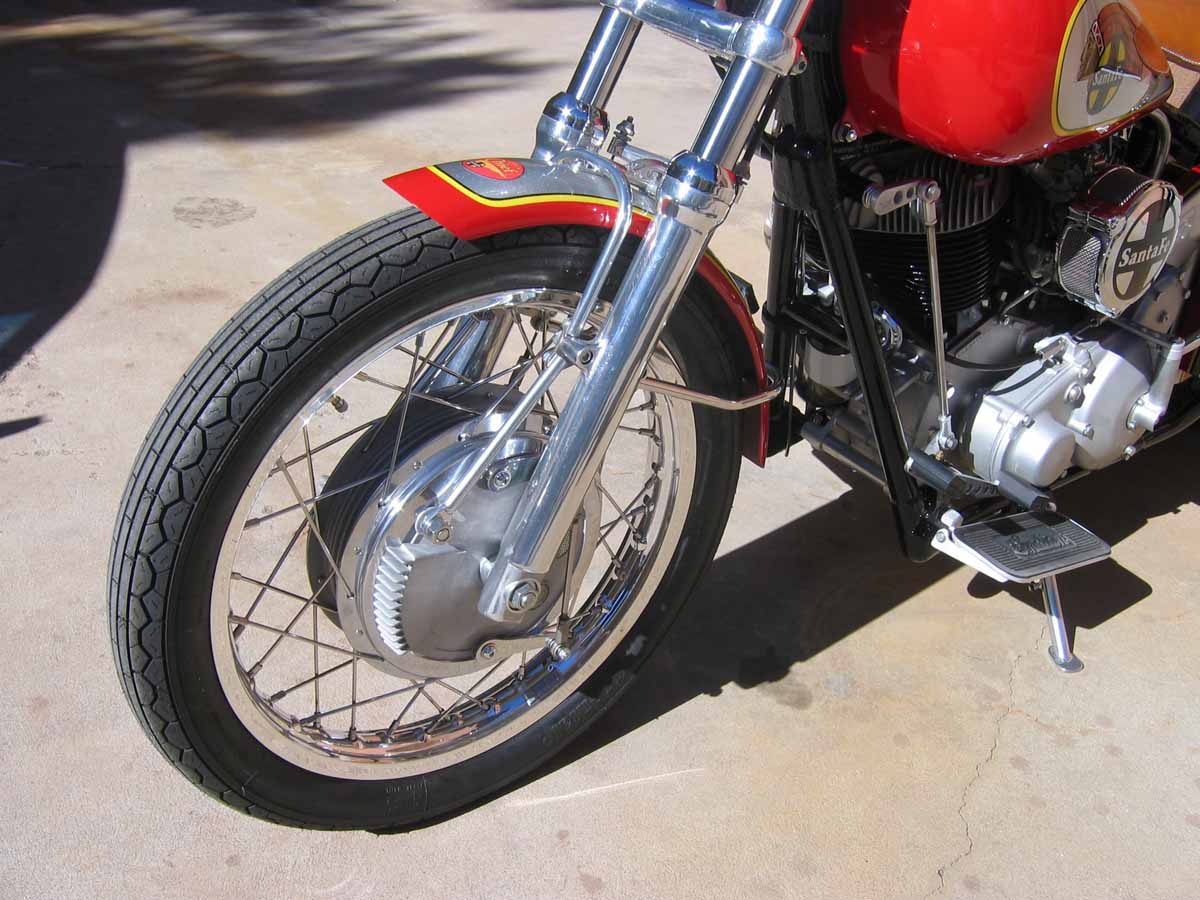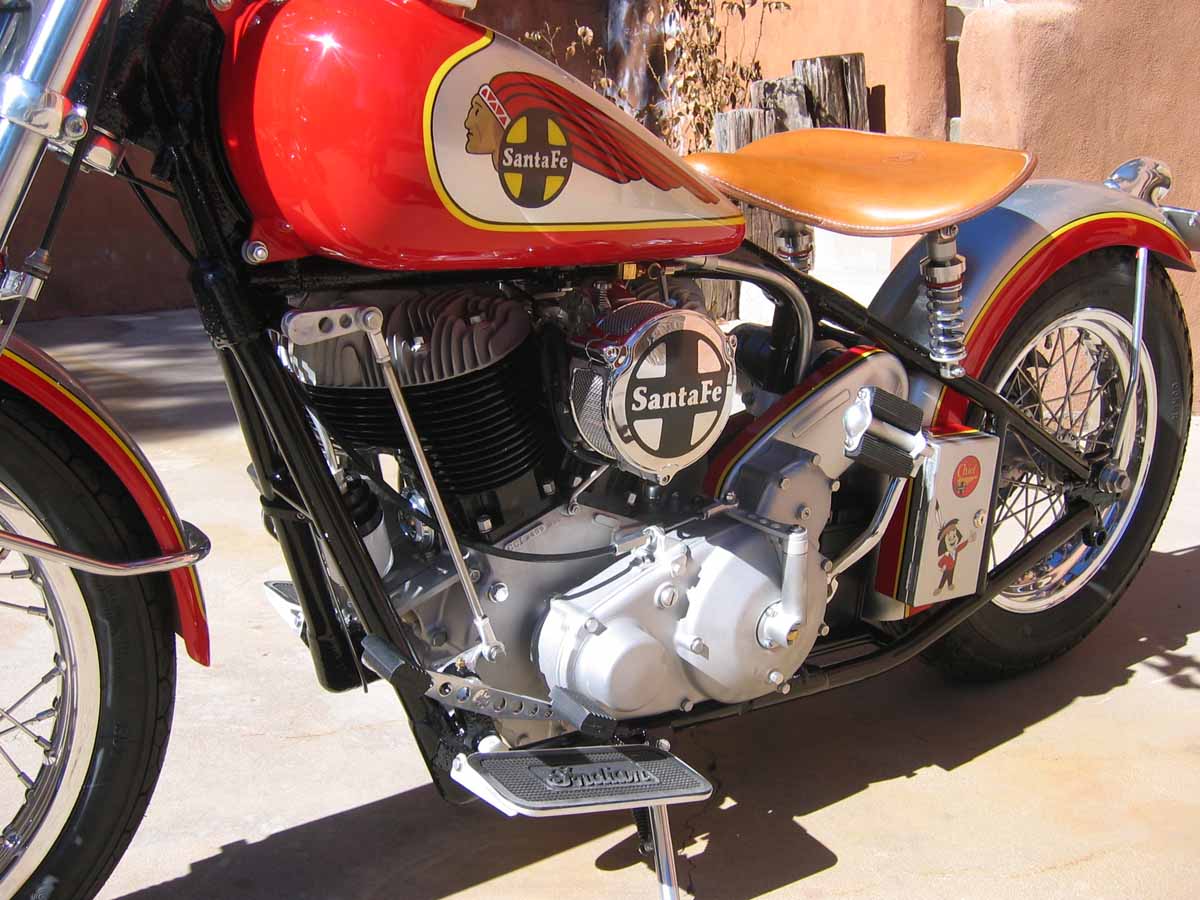SPEC SHEET FOR: JIM MOSHER'S 1933 INDIAN "SUPER CHIEF".
- Dry Weight: 440 Pounds.
- Custom made entirely by the owner (except where noted). I began with a very sad 1933 Chief frame that I had to cut-up to re-straighten. I added reinforcement bracing tubes to the front down-tubes, and to the rear frame section.
- Forks: The forks are 2002 Sportster "Showa" forks with a 3" lowering kit, and progressive springs. The fork neck was extended 1" for the longer Indian neck. I made special race cups for the frame to accept standard H-D tapered roller bearings. I made a special fork stem bolt using a "Crocker" steering damper knob.
- Fenders: The front is from a H-D FXR that I cut differently, and the rear is cut from the top crown of an Indian Chief skirted fender. I made special tube fender mounts, where the front stays also serve as a fork brace, as well as a cantilever "Balance-Beam" brake mechanism for the front brake.
- Tanks: I used Matt Blake's (Iron Horse Coral) excellent oversized 4 1/4 gallon replica Chief tanks without the seat "T" cut-out.
- Instrumentation: The 1947 style aluminum dash panel uses the original style ignition switch, and amp meter, but in place of the speedometer, I installed an Air/Fuel meter for advanced tuning with an oxygen sensor in the exhaust system. I installed a 3rd generation Trail-Tech "Vapor" digital speedo on the forks that has back-lighting, cylinder head temperature, and tachometer, as well as all the computer functions. On the dash panel, I added cool smooth buttons for the horn, and the Hi/Low beam. Instead of the (2) normal screws for the dash panel, I used (2) button-head screws with LED lights for the Generator light, and the Hi/Low function.
- Chainguard: I used a fiberglass replica of a mid-30s Chief chain guard. The belt guard is made up from (2) post-war Chief belt guards.
- Wheels: The front wheel is a 36 spoke Excell alloy WM-2 X 19" on a Grimecca Four-leading shoe Grand Prix racing brake/hub, as used on the MV Augusta in the 60's. The rear wheel is a 40 spoke Akront alloy WM-6 X 16" on a late 60's Triumph 650 Bonneville brake/hub. I made special axles, and spacers for both. THIS BIKE STOPS!!
- Tires: The front is a Continental "RB2" 3.25 X 19", and the rear is a Coker "Beck" style 5.00 X 16". I use 32 PSI front, and 22 PSI rear.
- Controls: The bars are "Malcolm Smith" alloy dirt bike bars (7/8"), and the levers are "ASV" forged dirt bike levers. I use a vintage chromed Thommaselli "Quick Throttle".
- Foot Shift/Hand Clutch: I custom made a hand clutch mechanism, and a foot shift pedal that rocks forward, and rearward through the gears. A "Ratchet" shift mechanism will follow soon. All the linkage rods are hollow thin wall stainless steel with heim joints for low mass, and a positive feel.
- Charging System: I use a 12 volt/15 amp "Cycle-Electric" generator (similar to a Pan-Head), with a 22" belt. It has an internal solid-state regulator. I use a 14 amp Yuasa sealed maintenance-free battery on a custom built tray. Amp meter, and a generator light are both used.
- Seat: Reproduction late Chief solo seat pan upholstered by Mark Arnold in Albequerque with beautiful tanned leather. I made up (2) seat springs using mountain-bike Gas shocks. I used lighter springs from the late Chief rear spring rebound springs in chrome. The seat springs are adjustable for weight, and rebound feel. These springs make the bike feel like a modern bike, inspite of being a rigid frame! I made special seat "T" mounting hardware.
- Lights: The front is a replica "Cycle-Ray" heavily modified to accept a 7" Euro sealed beam type "H-4" Halogen 100 watt bulb. I used a Chief Leaf spring headlight mount that I cut-up into 4 pieces, and re-assembled into a new piece. The rear lamp is an NOS 1951 vintage "Crocker-like" unit made in L.A. by BT&E (Barnett Tool & Engineering). It uses an LED bulb.
- Paint: Paint, and Body by owner (except the fine graphics, and black pin striping by "Geet" Faulkner of Colorado). I did the "Warpath" paint scheme as used on the passenger train line engines of the "Santa Fe Super Chief", which ran from L.A. to Chicago daily from 1937 through 1971. The tank logos are a combination of the Indian Chief/Scout head dress of the 30's, and the art-deco head dress used on the train's engines. The little boy on my tool box is "Chico", who was heavily used in their advertising during the "Super Chief's" last days. Typically, I hate "Theme bikes", but I live in a canyon on the east edge of Santa Fe, where my property line is the train tracks where this train ran. I got to ride the "Super Chief" twice in the 60's, and this Chief is a very hot-rodded bike, so the name "Super Chief" is very appropriate. Ya think?
- Floor Boards: 1920 Power Plus Indian.
- Ignition: I custom made a centrifugal advance distributor from a Crosley car, and I used a popular electronic ignition module. It fires a Dyna-Tek 3 Ohm mini-coil mounted between the tanks. Mallory high performance stainless steel wires are used to fire NGK BP8HS projected tip plugs set at .035" gap. The distributor advances from TDC to 25 degrees full advance as soon as the motor is started, and then only retards when the motor is killed. This system works extremely well!!
- Carb/Manifold: The manifold is the aluminum type that is heavily ported with "D" shaped ports in the turns. (It took 22 hours of porting work!). The carb is a Keihin 41mm CV type using a special Yost "Power-Tube" setup. I will have these available soon. Installation is via my custom CV carb kit that I make, and sell. At first I tried a Mikuni 40mm "Flat-Slide". The Mikuni performed well, but the CV worked a lot better! The CV makes more power, gas milage, and makes a lot less engine heat! A custom air cleaner housing hides a K&N air filter element.
- Pipes: The pipes, and glass-pack "slip-on" muffler are pieces I made up from parts that I got from D&D pipes in Fort Worth, Texas. I used formulas for high performance to build these, and they really work. I used larger 1 3/4" tube, and the target peak-torque is at 4,000 RPM. The pipes, as well as several other parts on the bike (pedals, fender stays, seat "T") are covered in Ceramic aluminum by Performance Coatings.com in Oregon.
- Motor: I used 80" S&S stroker flywheels (4 13/16" stroke), that are 15% lighter than stock, and balanced with a 60% balance factor. The cases are 1939 Bonneville Chief. The cylinders are late 80" Chief, that are ductile iron sleeved with (4) hard seats, a triple angle valve job, and nice porting. Rods are Gary Stark's Carrillo copies (H-beam). Heads are heavily milled, with re-shaped combustion chambers yielding 6.8:1 compression.
- Valve Train: The valves are the "Black Nitrided" type, that I lightened by 14%. Push rods are the spiral grooved type. O-ring valve covers are used. Jim Parker from Australia provided the special 7 coil (stiffer by 15%) valve springs for my high lift cams. I use original Bonneville lifters with Starklites needle bearing rollers installed by Wislon Plank.
- Cams: I adapted a set of "Shunk" Scout dirt track racing cams, which when used in a Scout the lift is .365", but when used in a Chief with Bonneville lifters, the lift goes to .486" lift!! Normally about .410" lift is the maximum for a Chief, but by relieving valve pockets in my heads, milling material away from the pinion bushing area in the cam case, as well as shortening my push rod tubes, all the parts fit without crashing into other pieces. Additionally, I did the research to position the lobes in a more optimum position for overall performance. I did this by moving the lobes 7 degrees each with off-set indexing pins. The end result is .486" lift (intake, and exhaust), 300 degrees duration measured just off the base circle. The following specs are taken at .053" lift off the base circle: Intake opens 23 BTDC, Intake closes 53 ABDC, Exhaust opens 53 BBDC, Exhaust closes 23 ATDC. This is 256 degrees duration with .053" lift measuring. The lobe centers are at 105/105. It ends up virtually identical to the well known "Andrews B Cam" for Pan Head, and Shovelhead H-D's. This combo yields the greatest low-end torque through high-end power of any Chief I've ever ridden!!
- Transmission: Frank Byford's Overdrive four-speed. I use a 25 tooth sprocket, but my rear sprocket is a 46 tooth Triumph, instead of the 43 tooth Chief sprocket. The equivelant is like a normal Chief with a 24 tooth sprocket. 65-70MPH is smooth cruising.
- Primary/Clutch: My primary is the late 80" style using the compensating sprocket on the drive side. It is fantastic. The motor's power delivery is very smooth, and never jerky. Well worth the extra money!! I use the Jerry Greer composite clutch pack with (7) steel discs (1 extra), and (3) less clutch springs for the perfect feel of my hand clutch. The Greer plates fully disengage in a small amount of travel, which gives my hand-clutch a very smooth feel.
- Oil Pump/Sump: I use a chromed 1947 Iron pump, and the 1947 style scraper sump. I also use the "Old Iron" oil filter.
- Pistons: I use JCC die-cast pistons, with .0045" cylinder to wall clearance. I use the Total-Seal rings (leave out the 3rd ring!), and an end gap of .012" for the compression rings. These piston tops are .150" above the deck at TDC.
- Other Features: Krank-Vent system routed through the frame. All wiring hidden in the frame, with modern water tight plugs, and a terminal strip between the tanks. All stainless steel button-head allen bolts, and aircraft lock nuts, and stainless "AN" washers are used throughout. I built a "left-side" kicker to get away from the dual exhaust system, using a Pan-Head kicker, the old-style bicycle pedal, and a Sportster kicker shaft for a very easy kicker. I also used the 1948 ball-type kicker gear, and a lower portion of a magneto Chief kicker.
Overall Impression: The paint scheme is striking. I used the highest grade (sparkle) metalic silver made to simulate the stainless steel skin of the "Super Chief" train, and I used Ducati Red (close to the train's red). It is trimmed in lemon yellow, and black pin striping. It really stands out in the sunlight. It always roars to life on the first kick (thanks to the hot ignition), and settles down to a nice cammy idle when warm. With the high compression, and the light flywheels, it revs instantly. I designed the ergos (seating position) to be very comfortable, and user friendly. It sits like a Buell S1, or a dirt tracker. Although it is a rigid frame, the Showa forks, and the gas shock seat springs make this bike ride like a new Sportster. With the hand-clutch, there is no need to ever take your hands off the bars. This comes in handy under full power riding! The handling in the turns is precise, with lots of ground clearance, and the brakes are great. The Grimecca front brake is like power-brakes! The motor makes tons of power everywhere, so with only 440 pounds dry weight, it is a very quick bike. I sorted everything out in the first 1,000 miles, and it has proven to be trouble free, and oil tight like a modern motorcycle. It is a joy to ride, and so far I'm confident it will be trouble free.
